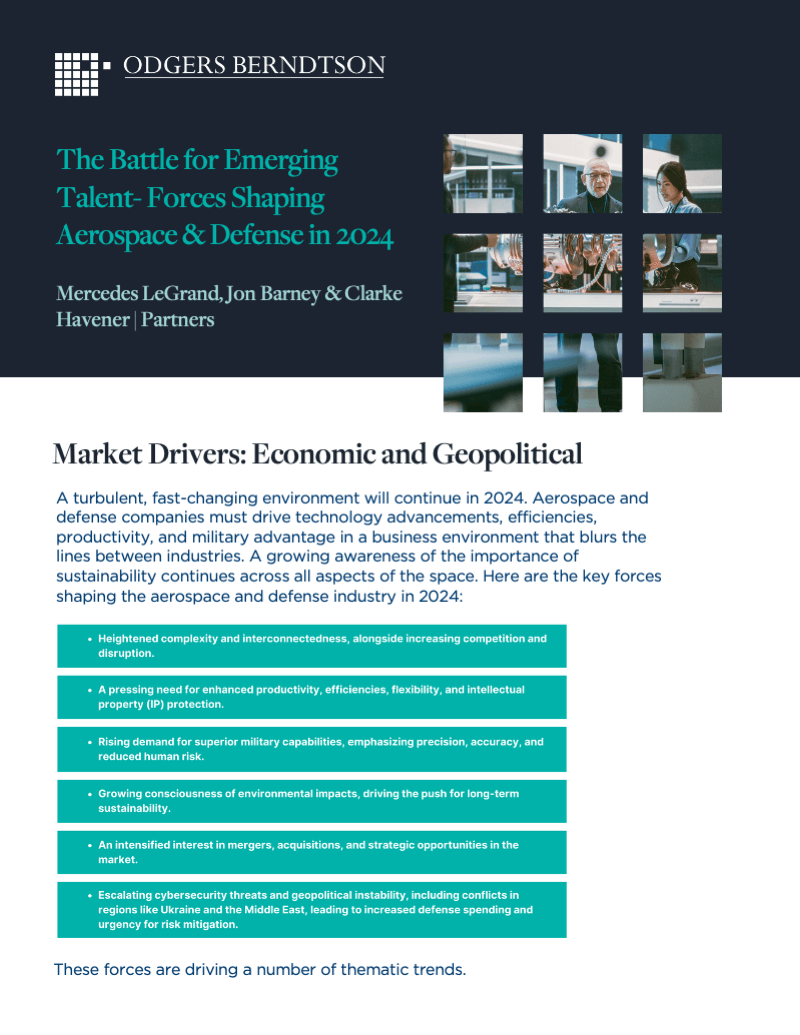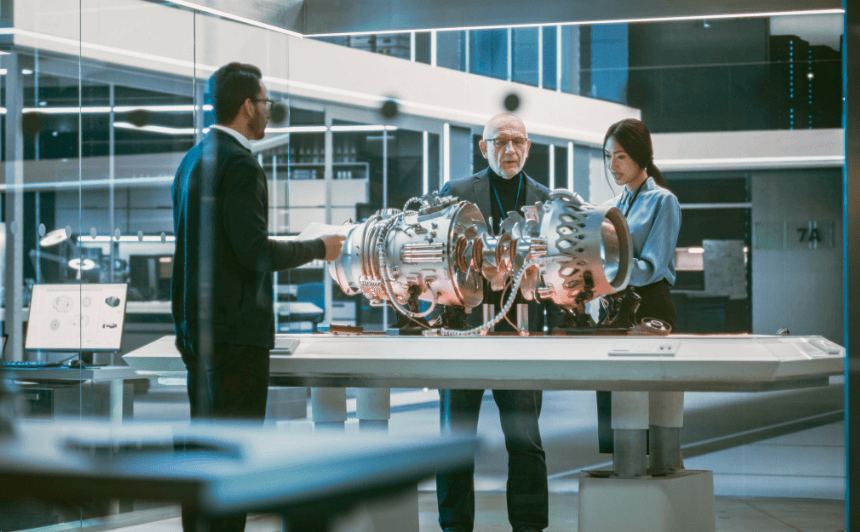Market Drivers: Economic and Geopolitical
A turbulent, fast-changing environment will continue in 2024. Aerospace and defense companies must drive technology advancements, efficiencies, productivity, and military advantage in a business environment that blurs the lines between industries. A growing awareness of the importance of sustainability continues across all aspects of the space. Here are the key forces shaping the aerospace and defense industry in 2024:

These forces are driving a number of thematic trends.
Trends in A&D
Advancements in Autonomy and Technology
The aerospace and defense industry is evolving rapidly with key technology developments, including:
-
Increased utilization of military drones and UAVs for surveillance, coupled with advancements in AI and machine learning for enhanced aircraft capabilities.
-
Growing interest in space exploration, focusing on the development of reusable rockets and spacecraft.
-
A strong emphasis on cybersecurity to safeguard military and commercial aircraft from digital threats.
-
A push for more fuel-efficient aircraft with lower emissions, reflecting environmental concerns.
-
Innovative use of 3D printing in aerospace manufacturing and the development of hypersonic weapons capable of exceeding Mach 5 speeds.
Focus on Sustainability and Environmental Impact
The aerospace and defense industry is experiencing significant shifts, focusing on sustainability and technological advancements:
-
Growing pressure from stakeholders for sustainable business practices, leading to cleaner manufacturing processes, waste reduction, and the use of technologies like 3D printing.
-
The rise of digital twin technology and increased demand for quieter, more energy-efficient technology with reduced emissions.
-
A shift towards hybrid/electric propulsion systems in both aircraft and ground vehicles to meet environmental goals.
-
Continuous advancements in reusable rockets and other sustainable technologies in the sector.
-
The aerospace and defense industry is increasingly hiring executives with expertise in green energy and sustainable manufacturing to steer these initiatives.
Evolution of Supply Chain Challenges
Having navigated through a supply chain crisis, the industry continues to face significant supply chain challenges:
-
Persistent focus on enhancing supply chain security and resilience in response to evolving challenges.
-
Surging demand for skilled supply chain professionals following years of exposed vulnerabilities.
-
Implementation of effective supply chain strategies and lessons learned from adjacent industries.
Fluidity of Workforce Dynamics
Aerospace and defense (A&D) is adopting new work dynamics and talent management strategies to support the industry’s evolution:
-
Innovating working models to bridge talent shortages and skill gaps in the industry.
-
Striking a balance between the industry's unique needs and national security with the trend towards remote work.
-
Integrating technologies to facilitate digital experiences, remote work, and decentralized decision-making.
-
Emphasizing the need for A&D employees to travel nationally and internationally to various sites as required.
-
Placing increased emphasis on diversity and inclusion in the workforce, alongside evolving soft skills for effective leadership in this dynamic sector.
Talent Implications for 2024
Increased complexity and risk require more sophisticated leadership capabilities
In the aerospace and defense industry, the talent landscape is evolving, with outperforming executives demonstrating key competencies:
-
Strong problem-solving abilities, teamwork skills, and adaptability to emerging technologies and industry changes.
-
A blend of leadership, strategic thinking, financial savvy, and deep industry knowledge.
-
Effective communication and collaboration with a range of stakeholders, including employees, shareholders, and government officials.
-
Capacity to pivot and grow businesses in markets influenced by geopolitics and technological advancements.
-
Experience in risk management, sustainability, and compliance, with the ability to address new demands and articulate these aspects to investors.
✔️ |
Leadership Capabilities - Checklist |
Resources |
| ⃣ | Implement executive assessments for both internal promotions and external hires to measure for necessary emerging skills | Leadership assessment |
| ⃣ | Ensure your executive development programs include modules on problem solving, teamwork, financial acumen, risk assessment, and communication skills | Leadership development |
| ⃣ | Attract executives who can anticipate demands and expectations around sustainability (potentially from other industries) | Sustainability Executive recruitment |
Roles are changing to reflect the need for specialized knowledge in advanced technologies
Reliance on advanced technologies is shaping the industry’s talent requirements. There is a growing need for:
-
Leaders skilled in managing interconnected systems involving AI, software, computer networks, and data.
-
Engineers and technicians to design, test, and maintain these sophisticated systems.
-
Executives who are well-versed in relevant regulations and the risks associated with these technologies.
-
Leaders and board members with advanced tech expertise to secure or enhance competitive advantage.
|
|
||
|
✔️ |
Knowledge and Skill in Advanced Technologies - Checklist |
Resources |
| ⃣ |
Assess board composition to ensure multiple board members bring tech expertise |
|
| ⃣ |
Attract executives from tech industry to fill board and executive seats |
|
| ⃣ |
Institute well-designed executive rotation programs to foster increased tech knowledge across business functions |
Today’s workforce needs to be managed with more flexibility and creativity
The aerospace and defense (A&D) industry is adapting to changing workforce dynamics and diversity, equity, and inclusion (DEI) imperatives, leading to novel talent management approaches:
-
Implementation of technology solutions to support flexible work arrangements and remote collaboration.
-
Enhancing soft skills like compassion, empathy, and creativity in leadership.
-
Reevaluating traditional career paths and worker classifications to foster greater innovation and inclusion.
-
Embracing more flexible and creative management strategies to attract specialized talent, thereby enhancing agility and competitive edge.
-
Increasing focus on the level of HR talent and the HR function's expertise in DEI as a key competitive factor.
✔️ |
Flexible and creative talent management - Checklist |
Resources |
| ⃣ |
Ensure top-notch HR talent in place, including DEI experience |
|
| ⃣ |
Develop openness to more flexible career paths and less linear path to promotion |
|
| ⃣ |
Assess your managers (and candidates) for soft leadership skills |
|
| ⃣ |
Promote cross-functional skill development |
|
| ⃣ |
Be creative in allowing fluidity across work environments. Determine where people are actually needed, and when |
|
| ⃣ |
Assess your culture’s DEI readiness |
Key, critical roles are emerging and/or significantly evolving
Significant changes are leading to the creation and evolution of key roles in A&D:
-
Increasing emphasis on areas like advanced technologies, risk management, sustainability, DEI, cybersecurity, and corporate/board communications necessitates dedicated roles.
-
The emergence of new roles and the evolution of existing ones to meet new responsibilities and focus areas.
-
Many of these new and evolving roles, especially in critical focus areas, are becoming part of the C-suite.
-
Where these roles already exist, they are increasingly reporting directly to the CEO.
-
Notable emerging or evolving roles include Chief Digital Officer, Chief Sustainability Officer, Chief Innovation Officer, Chief Supply Chain Officer, Chief Human Resources Officer, Chief Security/Cybersecurity Officer, Chief Growth Officer, and Chief Risk Officer.
✔️ |
Emerging and evolving roles - Checklist |
Resources |
| ⃣ |
Assess need for these roles and hire where necessary |
|
| ⃣ |
If these roles already exist in your organization, consider elevating them or developing the executives filling these roles as more sophisticated and well-rounded leaders |
|
| ⃣ |
Ensure alignment on KPIs and objectives for these newer roles to optimize success |
|
| ⃣ |
Ensure execs and board members with specialized expertise in areas like tech, sustainability, DEI and risk have access to investor comms as well as strategic planning |




